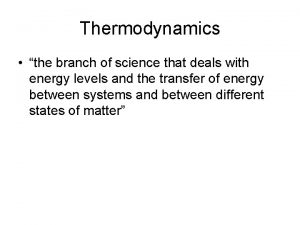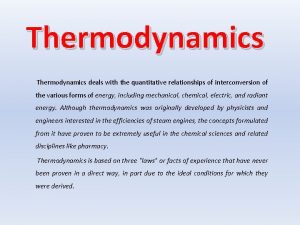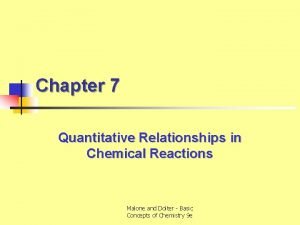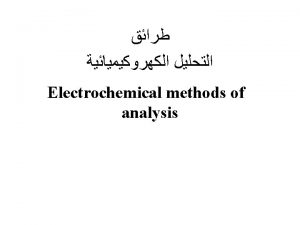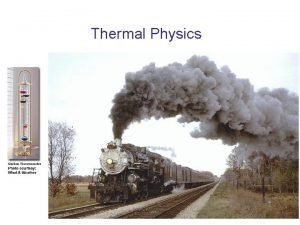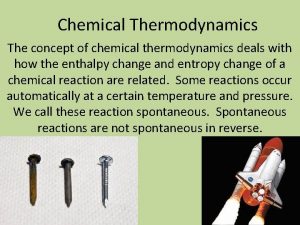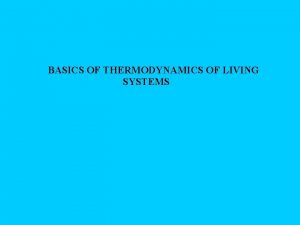Thermodynamics deals with the quantitative relationships of interconversion










- Slides: 10

Thermodynamics deals with the quantitative relationships of interconversion of the various forms of energy, including mechanical, chemical, electric, and radiant energy. Although thermodynamics was originally developed by physicists and engineers interested in the efficiencies of steam engines, the concepts formulated from it have proven to be extremely useful in the chemical sciences and related disciplines like pharmacy. Thermodynamics is based on three “laws” or facts of experience that have never been proven in a direct way, in part due to the ideal conditions for which they were derived.

System: A system in thermodynamics is a well-defined part of the universe that one is interested in studying. There are three types of systems: Open system in which energy and matter can be exchanged with the surroundings. Closed systems, in which there is no exchange of matter with the surroundings that is, the system's mass is constant. 2 Energy can be transferred by heat through the closed system's boundaries. Closed system: Energy can be transferred by work or heat through the closed system's boundaries. An isolated system: neither matter nor energy can be exchanged with the surroundings ﻡ 01: 29 24/05/2021

A system in thermodynamics is a well-defined part of the universe that one is interested in studying. The system is separated from surroundings, the rest of the universe and from which the observations are made, by physical (or virtual) barriers defined as boundaries. Work (W) and heat (Q) also have precise thermodynamic meanings. Work is a transfer of energy that can be used to change the height of a weight somewhere in the surroundings, and heat is a transfer of energy resulting from a temperature difference between the system and the surroundings. It is important to consider that both work and heat appear only at the system's boundaries where the energy is being transferred. The First Law of Thermodynamics The first law is a statement of the conservation of energy. It states that, although energy can be transformed from one kind into another, it cannot be created or destroyed. Put in another way, the total energy of a system and its immediate surroundings remains constant during any operation. 3 ﻡ 01: 29 24/05/2021

According to the first law, the effects of Q and W in a given system during a transformation from an initial thermodynamic state to a final thermodynamic state are related to an intrinsic property of the system called the internal energy, defined as : (1) where E 2 is the internal energy of the system in its final state and E 1 is the internal energy of the system in its initial state, Q is the heat, and W is the work. The change in internal energy ΔE is related to Q and W transferred between the system and its surroundings. Equation 1 expresses the fact that work and heat are equivalent ways of changing the internal energy of the system. In addition, this Equation also expresses the fact that work and heat are equivalent ways of changing the internal energy of the system. By using equation 1 (the first law), one can evaluate the change of internal energy by measuring Q and W during the change of state. However, it is useful to relate the change of internal energy to the measurable properties of the system: P, V, and T. Any two of these variables must be specified to define the internal energy. 4 ﻡ 01: 29 24/05/2021

Noting that the internal energy in an isolated system is constant for which Q=0 and W=0. On the other hand, the change in internal energy of a closed system is equal to the energy that passes through its boundary as heat or work. It employs the "acquisitive conversion", in which W>0 or Q>0 if energy transferred to the system as work or heat and W<0 or Q<0 if the energy is lost from the system as work or heat. Example: If an electric motor produced 15 KJ of energy each second as mechanical work and lost 2 KJ as heat to the surroundings. Calculate the change in the internal energy of the motor each second? For an infinitesimal change in the energy d. E, equation 1 is written as: (2) 5 ﻡ 01: 29 24/05/2021

where dq is the heat absorbed and dw is the work done during the infinitesimal change of the system. Capital letters Q and W are used for heat and work in equation (1) to signify finite changes in these quantities. The symbol d in equation (2) signifies infinitesimal changes of properties that depend on the “path, ” also called inexact differentials. Hence, dq and dw are not in these circumstances thermodynamic properties. The infinitesimal change of any state property like d. E, also called an exact differential, can be generally written, for instance, as a function of T and V as in the following equation for a closed system (i. e. , constant mass): (3) The partial derivatives of the energy in equation (3) are important properties of the system and show the rate of change in energy with the change in T at constant volume or with the change of V at constant temperature. Therefore, it is useful to find their expression in terms of measurable properties. This can be done by combining equations (2) and (3) into 6 ﻡ 01: 29 24/05/2021

(4) When the temperature is kept constant during a process, the reaction is said to be conducted isothermally. An isothermal reaction may be carried out by placing the system in a large constant-temperature bath so that heat is drawn from or returned to it without affecting the temperature significantly. Therefore, for perfect gas ΔE or d. E will be equal to 0 Q=-W. While when heat is neither lost nor gained during a process, the reaction is said to occur adiabatically. A reaction carried on inside a sealed Dewar flask or “vacuum bottle” is adiabatic because the system is thermally insulated from its surroundings. In thermodynamic terms, it can be said that an adiabatic process is one in which dq = 0, and the first law under adiabatic conditions reduces to (5) 7 ﻡ 01: 29 24/05/2021

Thermodynamic State The term thermodynamic state means the condition in which the measurable properties of the system have a definite value. Hence, the states of most interest to the chemist ordinarily are defined by specifying any two of the three variables, temperature (T), pressure (P), and volume (V). Any equation relating the necessary variables—for example, V = f (T, P)—is an equation of state. The ideal gas law is equation of state. Thus, V, P, and T are variables that define a state, so they are called state variables. The variables of a thermodynamic state are independent of how the state has been reached. A feature of the change of internal energy, ΔE, discovered by the first law is that it depends only on the initial and final thermodynamic states, that is, it is a variable of state; it is a thermodynamic property of the system. On the other hand, both Q and W depend on the manner in which the change is conducted. Hence, Q and W are not variables of state or thermodynamic properties; they are said to depend on the “path” of the transformation. 8 ﻡ 01: 29 24/05/2021

Work of Expansion Against a Constant Pressure Imagine a vapor confined in a hypothetical cylinder fitted with a weightless, frictionless piston of area A, as shown in this Figure. If a constant external pressure Pex is exerted on the piston, the total force is Pex × A because P = Force/Area. The vapor in the cylinder is now made to expand by increasing the temperature, and the piston moves a distance h. The work done against the opposing pressure in one single stage is (6) Now A × h is the increase in volume, ΔV = V 2 - V 1, so that, at constant pressure, (7) 9 ﻡ 01: 29 24/05/2021

Reversible Processes A reversible process can be explained by this Figure which must be at constant temperature is reversible because the energy accumulated in the surroundings in the expansion is exactly the amount required to compress the gas back to the initial state (P 1, V 1, T to P 2, V 2 and T). Fig. A reversible process: evaporation and condensation of water at 1 atm in a closed system. (a) System at equilibrium with Pex = 1 atm; (b) expansion is infinitesimal; (c) compression is infinitesimal. 10 ﻡ 01: 29 24/05/2021
 Interconversion of states of matter
Interconversion of states of matter Plastid are present in
Plastid are present in Thermodynamics is a branch of science which deals with
Thermodynamics is a branch of science which deals with Thermodynamics deals with
Thermodynamics deals with Lesson 2.2 relationships between two quantitative variables
Lesson 2.2 relationships between two quantitative variables Quantitative relationships in chemical equations
Quantitative relationships in chemical equations Lesson 2.2 relationships between two quantitative variables
Lesson 2.2 relationships between two quantitative variables Thiếu nhi thế giới liên hoan
Thiếu nhi thế giới liên hoan Khi nào hổ con có thể sống độc lập
Khi nào hổ con có thể sống độc lập Hát lên người ơi
Hát lên người ơi điện thế nghỉ
điện thế nghỉ


